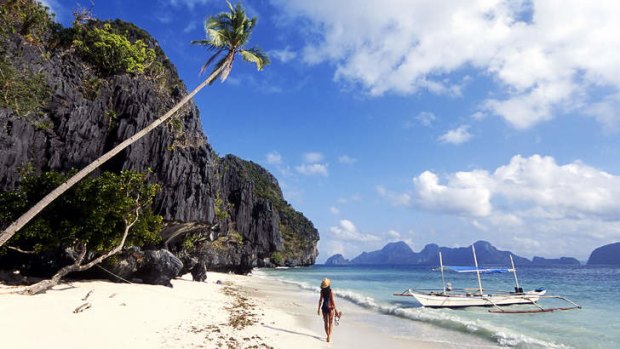
Strolling along the beach in El Nido, Palawan.Credit: John Seaton Callahan / Getty Images
The Philippines is often overlooked by Australians in favour of other Asian destinations, but there's no better time to get to know this tropical archipelago, writes Steve McKenna in this beginner's guide.
With 7107 islands and a feast of screensaver-perfect backdrops - from dreamy tropical beaches and smouldering volcanoes to mesmerising rice terraces and crumbling Spanish relics - the Philippines is one of south-east Asia's most exotic getaways.
Yet to many Australians, this lush archipelago - anchored between the South China Sea and Pacific Ocean - remains an under-appreciated mystery; usually ignored in favour of its near-neighbours Thailand, Vietnam, Malaysia and Indonesia (Bali), despite the efforts of Filipino tourism chiefs, whose slogan: "It's More Fun in the Philippines" graces the billboards in Australia.
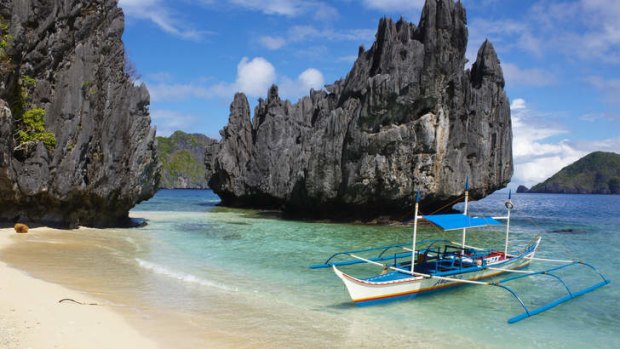
Exotic encounters: Palawan Island, Boracay's White Beach.
So why take a punt on the Philippines? Aside from the fact that low-cost Filipino carrier Cebu Airlines will next month launch flights between the Philippines, taking on both national carrier Philippine Airlines and the homegrown Qantas and the fact that you're dealing with bargain, Bali-esque prices, what is there that appeals here?
How about gorgeous landscapes, a spellbinding cast of wildlife (both on land and under water), exuberant festivals, romantic hideaways and thrilling adventures, sumptuous seafood and rum-fuelled parties and the chance to mingle with some of the cheeriest people on earth.
And you'll have no worries communicating with them. Alongside Tagalog (Filipino), English is the Philippines' official language (a legacy of the country's strong American influence).
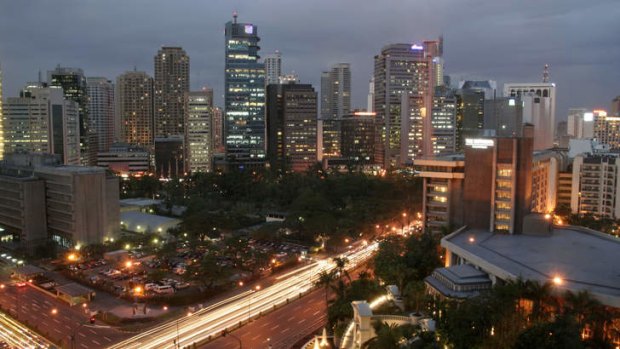
The Manila skyline at dusk.Credit: iStock
Compiling a maiden Filipino travel itinerary can be tricky (did I mention there were 7107 islands?).
So here are some ideas to get you started.
MANIC MANILA
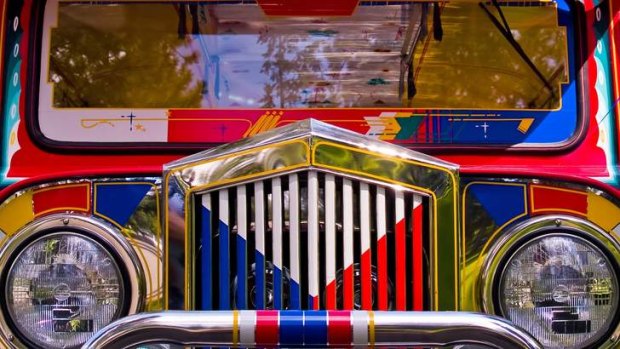
Classic Filipino Jeepney.Credit: iStock
Most travellers fly into Metro Manila, which, with its Bangkok-style traffic jams and its glaring chasms between the ostentatiously rich and the heart-wrenchingly poor, provides an in-your-face introduction to the Philippines. However, the Filipino capital is an absorbing and enthralling place to explore.
To familiarise yourself, join a walking tour with Carlos Celdran (celdrantours.blogspot.com), an acclaimed guide who uses street theatre to trace Manila's topsy-turvy history. His signature tour covers Intramuros - the photogenic, and fairly placid, old walled quarter founded by the Spanish colonialists in the early 16th century.
It was partially rebuilt after being flattened during World War II when the US and Japan fought for control of the city, then known as the pearl of the Orient. Another Celdran tour (Livin' La Vida Imelda) explores the controversial life of Imelda Marcos, the shoe-loving wife of former dictator Ferdinand Marcos. She was was said to have owned 3000 pairs of shoes when first lady.
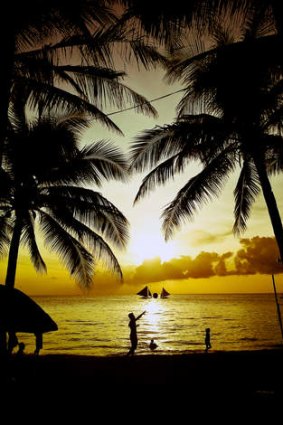
Boracay White Beach.
You can shop for nifty footwear, and other goodies, in the sleek airconditioned malls beloved by Manilenos across the social spectrum (the fanciest are in Makati, a modern American-tinged enclave strewn with cosmopolitan hotels and restaurants). Don't miss the sunset over Manila Bay; it's the city's traffic pollution that contributes to the startling orangey-red spectacle.
After dark, kick back with drinks on a trendy rooftop bar such as Skye (skye.ph) or try your luck at Manila's new $1.3 billion Solaire casino (solaireresort.com). You could also partake in the national obsession: singing. Karaoke bars are everywhere; some are family-friendly, others not so, dripping in neon and sleaze, rife with sex tourists and ladies, and lady-boys, of the night.
THE BIG ISLAND
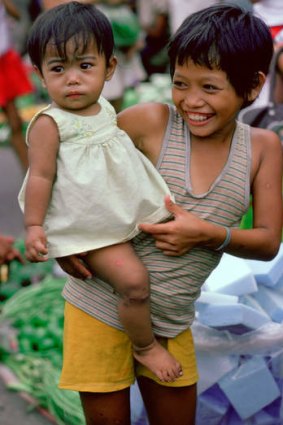
A little sister gets a lift.Credit: Getty Images
Manila sprawls at the centre of the Philippines' largest island.
A touch smaller than Cuba, Luzon could easily eat up the 30-day visa-free allowance that Australian passport holders are given upon entering the country.
After the smog, heat and bustle of Manila, it's bliss to ascend into the cooler Cordillera, a pine-forested chain of mountains sheltering laid-back towns like Sagada, a faintly mystical, hippy hideaway, and Baguio, a hill station established by the American military, who forced Spain out of the Philippines in 1898.
The Cordillera hides waterfalls, sacred caves with entombed mummies and museums that depict the customs of ancient headhunters.
But the main pull is the UNESCO World Heritage-listed rice terraces skirting the small towns of Banaue and Batad.
Dating back to the days before Christ, these magnificent amphitheatres — hewn with hand, mud and stone by the Ifugao people (one of several tribes still living in the region) — are edged by invigorating hiking trails. Travellers can do bamboo and nipa hut home-stays in Batad, where the worst of the noise pollution comes from crowing roosters and playful children.
Further north, the Philippines' best-preserved Spanish town, Vigan, has cobblestone streets, Mediterranean mansions, sturdy Catholic churches that were built to withstand earthquakes; one form of disastrous natural phenomena that the Philippines is vulnerable to and vibrant festivals like January's Vigan Town Fiesta - it's a blaze of colour, music and processions.
You can tour Vigan in a calesa, a two-wheeled horse carriage that is just one of the country's eye-catching (and often hair-raising) modes of transport. Most prevalent is the jeepney. A Philippines classic, the ex-US Army jeeps-cum-minibuses daubed in technicolour graffiti spawning messages of love, politics and religion. Similar designs cover tricycles, the Filipino rickshaws that are basically motorbikes with bolted-on sidecars.
In South Luzon, you can swim with giant butanding (whale sharks) off the coast of Donsol, and climb smoking Mount Mayon (a perfect cone volcano blooming from rice fields). Volcanoes loom either side of Manila. Day-trippers scale Mount Pinatubo, which last erupted in 1991, and Taal, which emerges, rather magically, out of a lake.
BORACAY BLISS
Choosing the Philippines' most beautiful beach is nigh-on impossible; there are so many. The most hyped is Boracay Island's White Beach, a luscious, four-kilometre lick of powdery sand, edged by giant, lurching coconut palms and stroked by gentle azure waters crawling with paraws (traditional sailing boats).
Though Boracay is paradise to many Filipinos (and South Koreans, Taiwanese and Chinese, who comprise the bulk of the international tourists), some complain that it's become too developed.
Compared to Thailand's Patong and Bali's Kuta, however, Boracay is still pretty laidback. And as I enjoy a seafood platter — grilled squid, octopus, shrimps and snapper - with a chilled San Miguel beer, while watching the sun melt into the sea, sending the sky into a frenzy of pinks and oranges, White Beach doesn't seem such a bad place to linger.
The bill, by the way? 600 pesos ($14.80).
SEE CEBU
Less frenetic than Manila, Cebu is the Philippines' second major gateway. Its international airport is on Mactan Island, where Iberian explorer Ferdinand Magellan met his end at the hands of tribal leader Lapu-Lapu in 1521.
A 20-minute taxi ride away, Cebu City boasts the country's oldest street and church, a ruined Spanish fort, and renowned eateries, like Zubuchon, where globetrotting celebrity chef Anthony Bourdain feasted on lechon (spit-roasted suckling pig). His verdict? "Best pig ever!"
While not as famous as Thai or Vietnamese food, Filipino cuisine is pretty varied and flavoursome.
Touted as the national dish, adobo is a vinegary, garlicky stew that comes in beef, pork and chicken variations, with rice.
It's served everywhere, from upscale bistros to boisterous street markets where families and friends munch and socialise around plastic tables and chairs.
Balut (half-developed duck embryo) is among the more offbeat culinary options. A favourite Filipino dessert is halo-halo, a revitalising concoction of milky crushed ice, fresh fruit (like mango, banana and papaya) and ice-cream.
The hub of the Visayan archipelago, Cebu is the launchpad for ferries and catamarans to myriad tempting islands, best explored on a motorbike or bicycle. Gems include Siquijor which is famed for its witches and shamans and the bucolic Bohol, which is on the road to recovery after suffering back-to-back jolts in late 2013.
A devastating 7.2 earthquake was followed three weeks later by Typhoon Haiyan (or Yolanda, as it was known in the Philippines).
Although some of Bohol's centuries-old churches were reduced to rubble, its iconic, tubby Chocolate Hills are still largely intact.
These 100-metre high mounds turn brown in the dry season between April and May (but are a luxuriant green during my February visit).
Another Bohol highlight is the tarsier. You can glimpse these cute, wide-eyed creatures — some of the planet's tiniest primates — in the trees of Bohol's Philippine Tarsier Sanctuary.
BEST OF THE REST
Like Borneo, Palawan conjures up a sense of the far-flung and unexplored. Its languid provincial capital, Puerto Princesa, is just an hour's flight from Manila, but oozes Eden-esque qualities.
One of the few pockets of civilisation, El Nido is a traveller-friendly town surrounded by hulking limestone cliffs, pristine beaches and sparkling emerald lagoons. Hop in a bangka (an outrigger vessel) or kayak and imbibe scenery that resembles Phi Phi in Thailand, only with a fraction of the tourists. North of Palawan, the Calamian Islands are believed to have inspired Alex Garland to write The Beach.
Calamian includes the hallowed wreck-dive spot of Coron, where more than a dozen Japanese ships were sunk during World War II. Coral-rich reefs teeming with tropical fish, turtles, sharks and dugongs, pepper Filipino waters, with world-class dive sites off Panglao Island, south of Bohol, Apo Island, off Negros, and Puerto Galera, Mindoro.
In the Philippines' deep south, hardcore surfers tackle the "Cloud Nine" break off Siargao Island, while adventure-seekers are drawn to Camiguin, a pear-shaped island with seven volcanoes. Both are near Mindanao (the country's second largest island), which is seducing more tourists after decades of political unrest.
Mindanao's Catholic-majority north is already deemed safe to visit, and, with peace talks ongoing, it's hoped the deserted beaches and misty mountains of the Muslim-majority centre and west will gradually become a hot-bed for wanderlustful travellers. Watch this space.
The writer travelled as a guest of Philippine Airlines, the Philippines' Department of Tourism and associated partners.
ABOUT THE WRITER
A regular contributor to Traveller, Steve McKenna has visited, and written about, more than 80 countries, and reserves a special affection for Europe, Latin America and south east Asia. But it's the diversity of travel that most excites him.
TRIP NOTES
GETTING THERE
Philippine Airlines flies from Sydney to Manila four times weekly, with return fares from $789. From Melbourne there are three flights a week (fares from $870). Connect on PA's budget airline PAL Express to the Filipino islands. See philippineairlines.com. Cebu Pacific is offering tickets for under $500. See cebupacificair.com/au-en. Qantas also flies regularly between Sydney and Manila, with fares from $977 return. See qantas.com.au. Ocean Jet ferry services link the Visayan islands and Mindanao. See oceanjet.net.
STAYING THERE
Bayleaf Hotel, a tranquil option amid Manila's hubbub. Rooms from $74. See thebayleaf.com.ph.
Palawan Legend Hotel, a launchpad for tours around Palawan. Doubles priced from $76. See legendpalawan.com.ph.
Crimson Resort & Spa, a deluxe beachside hideaway 45 minutes from central Cebu. From $190. See crimsonhotel.com/mactan.
Marco Polo Plaza Hotel, a smart choice above the city, from $50. See marcopoloplazacebu.com.
Grand Vista & Spa Resort has a magnificent hilltop location just north of White Beach, rooms from $120. See egrandvista.com.
Discovery Shores - this five-star hotel is one of Boracay's plushest; rooms from $330. See discoveryshoresboracay.com.
MORE INFORMATION
itsmorefuninthephilippines.com; smartraveller.gov.au.
TEN ESSENTIAL PHILIPPINES EXPERIENCES
1. Sip Tanduay rum and coke, a San Miguel or a fresh fruit juice while soaking up a Boracay sunset.
2. Filipinos are rarely more gleeful than during karaoke sessions. Go on, join in.
3. Hike through and marvel at the ancient rice terraces lording over Banaue and Batad.
4. Rub shoulders with a cocktail of humanity in a jeepney (either inside or on the roof).
5. Ogle awe-inspiring wildlife, whether it be tarsiers on land or butanding under water.
6. Indulge your inner mall rat and relax the purse strings in Manila's glut of shopping centres.
7. Navigate turquoise Filipino seas in a ferry, kayak or bangka (outrigger boat).
8. Enjoy a succulent - and wallet-friendly - seafood feast under a moon-lit sky.
9. You'll be offered hundreds of massages on your Filipino holiday. Accept one (at least).
10. Stumble across your own empty, postcard-perfect tropical beach.
Five more forgotten places
SOUTH KOREA
After a soju-fuelled night out in the mega-city of Seoul, escape into the South Korean countryside, live like a monk while staying in a Buddhist temple, and hike in the magnificent, mountainous Seoraksan National Park. Don't miss a tour of the nature-rich DMZ: the demilitarised buffer zone between the two Koreas. See english.visitkorea.or.kr.
LAOS
Take a two or three-day cruise along the Mekong River from Huay Xai, a sleepy village on the Laos-Thai border, to lovely Luang Prabang. Fringed by hilly countryside, the former royal capital is a riverside jewel blessed with temples, craft markets and picturesque mansions dating back to French colonial times. See tourismlaos.org.
SRI LANKA
Sri Lanka has enjoyed a mini-tourism boom after the end of its civil conflict. Surfers, tea drinkers, cricket fans, safari seekers, culture vultures, curry lovers and history buffs will all find something to savour in this ex-British colony. See srilanka.travel.
CAMBODIA
Beyond Angkor Wat, the uber-popular icon of Cambodia's revitalised tourism industry, swish resorts have sprung up on the palm-fringed southern coast, while Battambang - a riverside city 300 kilometres north of the frenetic capital Phnom Penh - charms visitors with its arty vibes, well-preserved French-period architecture, lavish hilltop temples and idyllic rural surrounds. See tourismcambodia.org.
BHUTAN
Unlike some Asian countries, which adopt a mass-market approach to tourism, the landlocked Buddhist kingdom of Bhutan - which only opened its doors to the outside world in 1974 - attracts a more discerning type of traveller. A minimum tariff of $US200 ($215) is levied on each visitor a day (that fee includes accommodation, food, transport and an official guide). See tourism.gov.bt.
FIVE MORE TIPS FOR THE PHILIPPINES
1. You'll easily get by with English, but knowing a few Tagalog phrases won't do you any harm (such as "salamat po" - thank you).
2. Don't try to cram too much in. You can fly or ferry to many places, but sometimes land travel is the only option and it's time-consuming. Banaue to Manila, for example, is 330 kilometres, but takes seven to 10 hours by bus; Puerto Princesa to El Nido is six to eight hours.
3. Filipinos have a saying: "bahala na" (roughly "what will be, will be"). Best to adopt this strategy here, especially when faced with delays.
4. Keep abreast of political scandals and cultural fads with the Philippine Daily Inquirer; see inquirer.net.
5. The best time to visit is roughly between December and May. Monsoon season is between June and November.
Sign up for the Traveller Deals newsletter
Get exclusive travel deals delivered straight to your inbox. Sign up now.